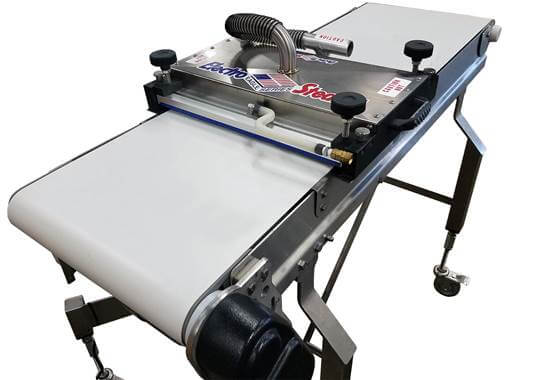Benefits of Clean-in-Place Dry Steam Cleaning for Conveyor Belts
Food processing and production environments are required to comply with sanitation and food safety standards at all times. These apply to the ingredients as well as all equipment used to prepare, process, and package them.
Areas that require special attention include conveyor belts used to move food items from station to station within the facility, tubing that transports ingredients and finished products, and food preparation equipment. Because they are in contact with food products continuously, they readily pick up stains, debris, and contaminants. If they are not cleaned frequently and adequately, risks of cross-contamination or reduced product quality increase.
Steam sanitation is a quick and cost-effective method of cleaning and sanitizing food-contact surfaces and equipment that’s highly effective. What’s more, systems that allow workers to bring steam cleaning equipment to the point of use rather than disassembling and moving equipment, known as clean-in-place systems (CIP), boost operational efficiency. Here, we’ll discuss how CIP dry steam cleaning works and its many advantages for conveyor belts and food production facilities.
What Is Clean in Place (CIP)?
CIP systems allow equipment to be cleaned thoroughly without disassembly or transportation to a different area for washing and sanitizing. It is frequently used with bulky equipment, large machinery that is heavy or permanently installed, or complex equipment that is difficult and time-consuming to take apart and reassemble. Clean-in-place equipment is usually a portable setup with a dry steam generator, cleaning tools such as spray wands for reaching tight spaces, a vacuum system for particles and liquids, and sometimes a specialized belt cleaning device.
Dry steam cleaners release high-temperature dry steam on, around, and into equipment. Dry steam has a low moisture content, so hand drying is not required. Temperatures are hot enough to melt grease, destroy biofilms, kill pathogens, and loosen crumbs or other stuck-on residues or carryback so they can be vacuumed up. Depending on the application, dry steam can also be fed into tubing lines and through filling nozzles or sprayers for glazes and coatings.
Dry steam is ideal for reaching into crevices and intricate assemblies. Steam can easily reach small gaps, rough edges, and different components far inside assemblies, releasing residues, particles, dust, and fatty substances far more effectively than hands-on cleaning. A special vacuum system is used to remove particles and the small amount of water that condenses as the steam cools.
Because dry steam has only a 5 to 6% moisture content, the amount of liquid generated by the cleaning process is minimal. This helps to avoid corrosion or other water damage and eliminates standing water that can support bacteria.
Advantages of CIP Technology
CIP dry steam sanitizing systems have several benefits for food processing and production operations including:
Increased Speed and Productivity
Steam sanitization with CIP systems is faster than manual processes. CIP cleaning eliminates the time and labor for disassembling and moving equipment, as well as the actual time and effort required to manually clean different components and reassemble them. High-temperature steam also requires shorter dwell times than other cleaning agents, quickly melts grease, and kills pathogens. This results in more consistent and thorough cleaning and less downtime.
Greater Reliability
Dry steam can reach all the surfaces of a conveyor belt and into even the smallest channels or tubing. Manual cleaning methods involving a range of tools and cleaning solutions may not be able to reach some areas reliably. This may leave the level of sanitation to the skill of the person doing the cleaning, which can vary. CIP dry steam cleaning makes it easier to comply with the Food Safety Modernization Act (FSMA) and other requirements. High-temperature steam kills pathogens like Listeria monocytogenes, Escherichia coli (E. coli), and salmonella, and removes potential allergens, dust, and other particles.
Improved Worker Safety
CIP dry steam cleaning eliminates the need for disassembling, moving, and reassembling equipment, greatly reducing the risks of worker injury and improper reassembly or equipment damage. With its low moisture content, dry steam leaves minimal wet residue, further reducing slips, falls, and chemical exposure from water- or chemical-based manual cleaning processes.
Superior Eco-Friendliness
Sanitizing with CIP dry steam cleaning systems is environmentally friendly. It doesn’t require potentially hazardous cleaning agents or consumables like cloths or sponges that can be reintroduced to the water supply. CIP dry steam cleaning reduces water consumption by using up to 98% less water than wet cleaning methods.
Contact Electro-Steam for CIP Dry Steam Cleaning
The ability to steam in place saves time and results in consistently clean equipment for compliance with food safety regulations. Electro-Steam is a leading provider of custom steam systems for clean-in-place food industry applications as well as commercial kitchens, wineries, medical device manufacturing or preparation facilities, and more We also carry industrial process steam and clean steam generators, cleaning tools, and accessories like brushes, hoses, and more.
Contact us today to learn more about dry steam CIP systems or schedule a free demo to see our equipment in action.

 Proudly Made in the USA
Proudly Made in the USA 